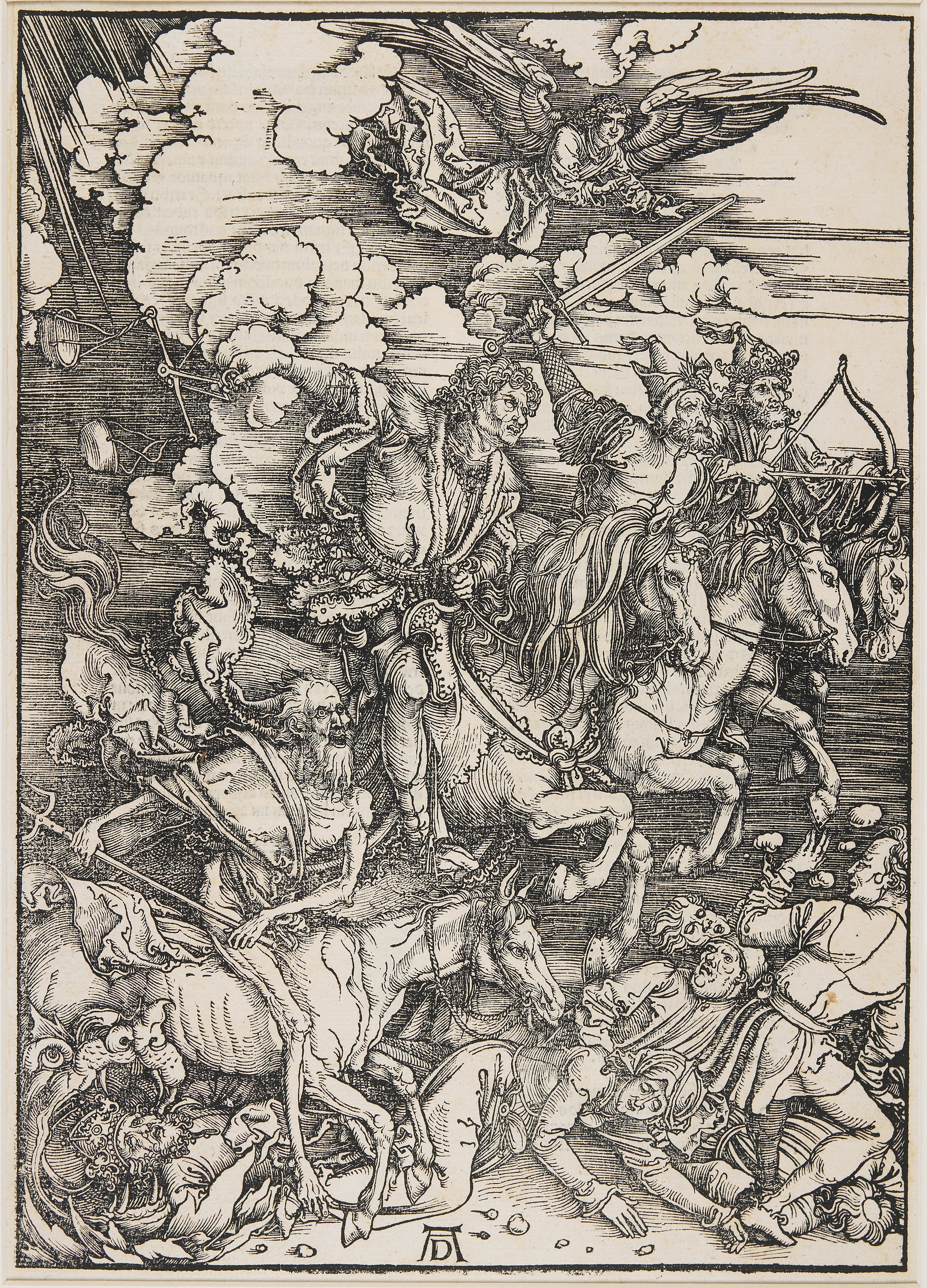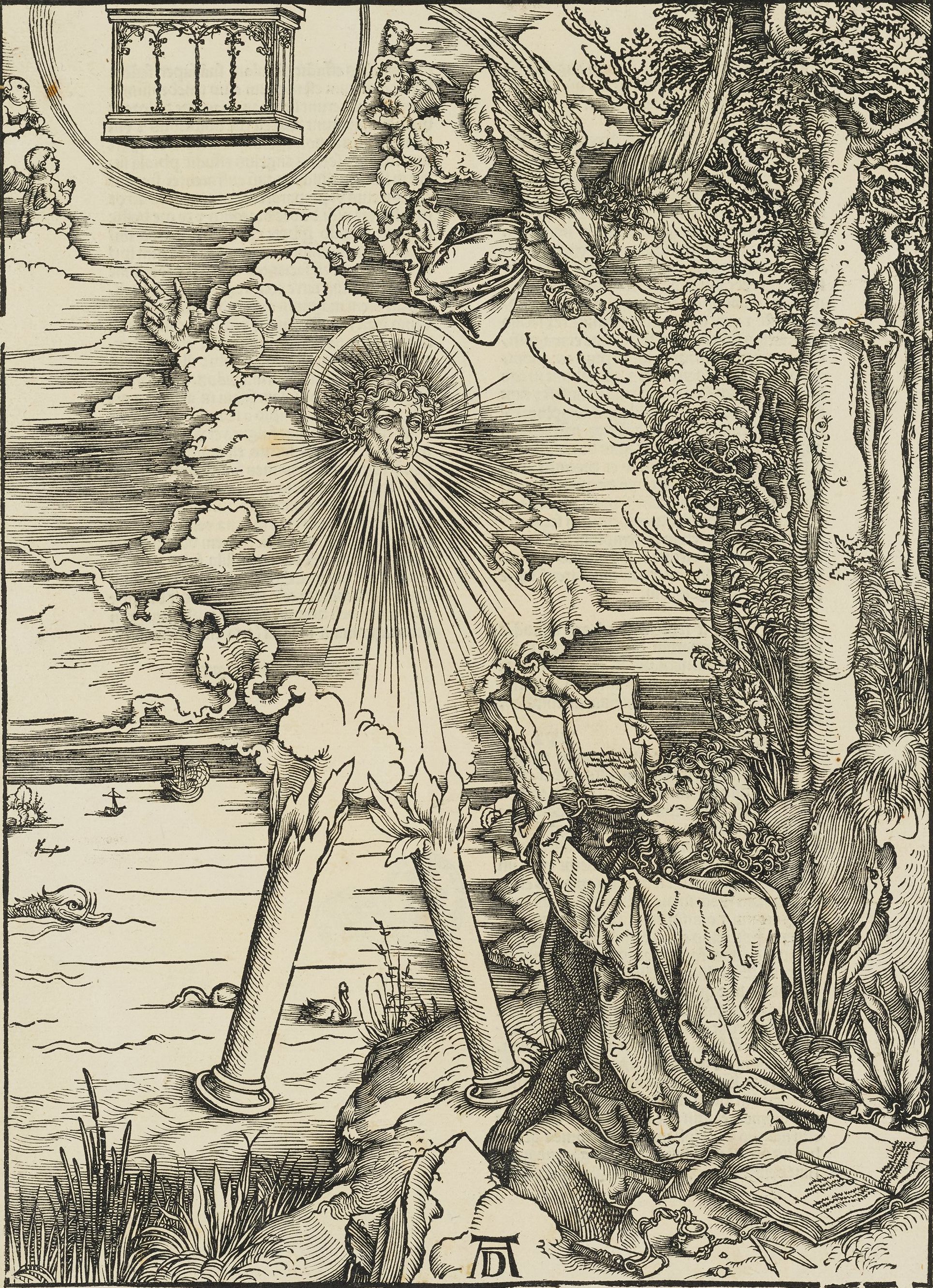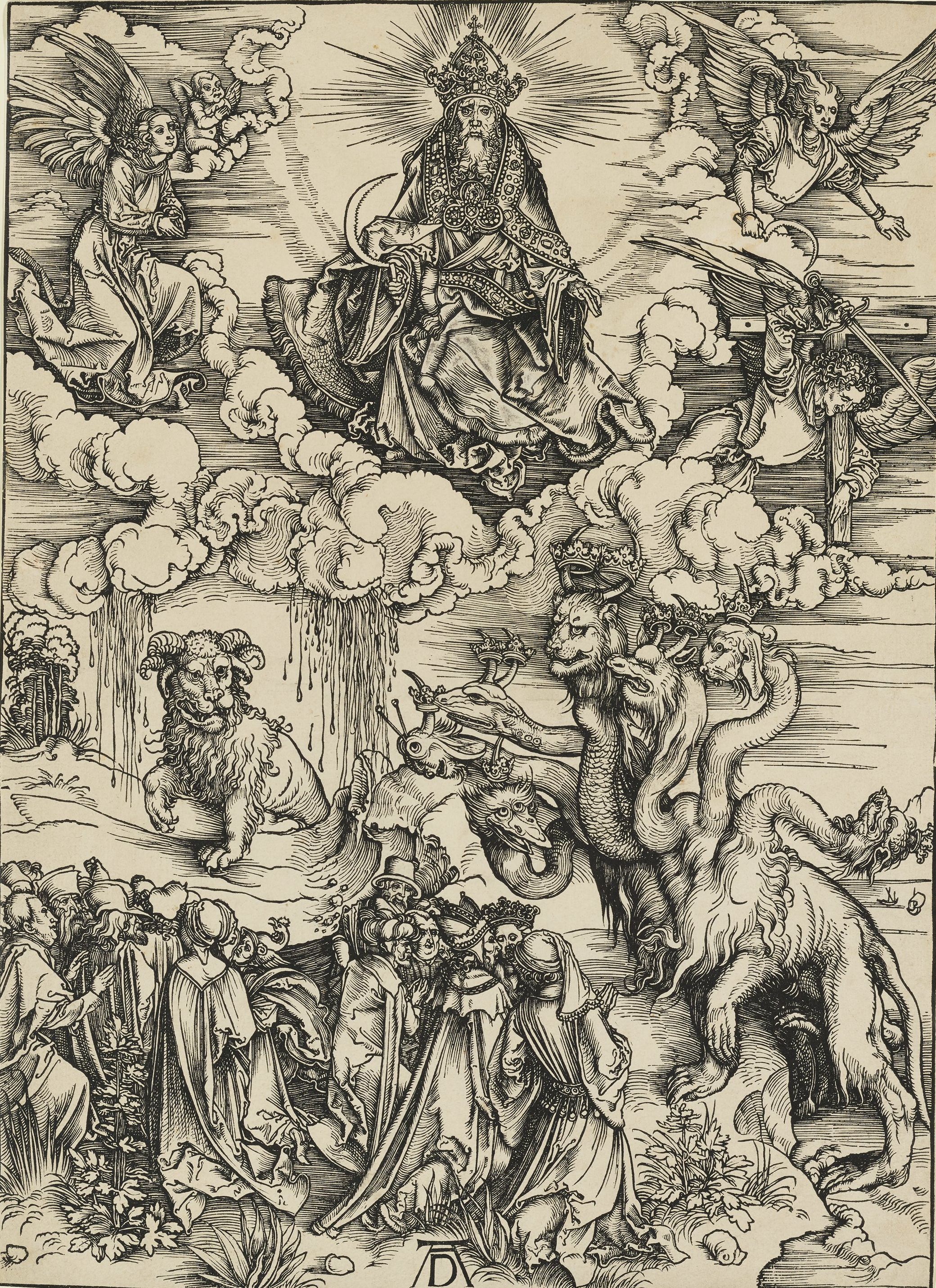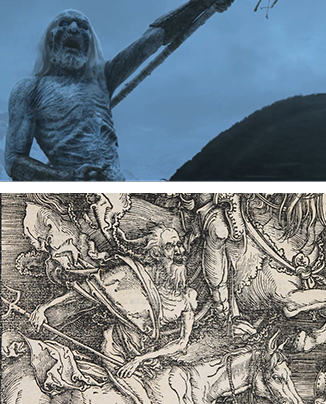Game of Thrones, HBO’s most popular television show, premieres its seventh season on July 16. After watching the series for six seasons, I’ve become more and more intrigued by the resemblance between the televised drama inspired by George R.R. Martin’s fantasy novels and a set of woodcuts by the Renaissance artist Albrecht Dürer (1471–1528). Issued in 1498, Dürer’s 15 innovative woodcuts known as the Apocalypse made the 27-year-old German genius internationally famous. They are based on the Book of Revelation in the Bible and bring to life a terrifying, violent, and vivid vision of the world’s end that, for me, continues to echo in Thrones.
The woodcut during the Renaissance was not unlike television today, reaching a mass audience as a powerful channel of popular culture. Albrecht Dürer elevated the woodcut to a fine art, just as HBO has raised the bar for dramatic series like The Sopranos and now Thrones. Dürer and HBO also brought new ambition and capital investment to their respective enterprises, creating works of stunning complexity and unprecedented production value. But beyond these similarities, what I find most fascinating is the way the Apocalypse and Thrones resonate with each other in their storylines, cast of characters, costumes, and dramatic action. Let’s look at some of the woodcuts to pull out the common threads.

 Above: Albrecht Dürer, “The Babylonian Whore,” 1498, woodcut, plate 14 from the “Apocalypse,” Bequest of Herschel V. Jones
Above: Albrecht Dürer, “The Babylonian Whore,” 1498, woodcut, plate 14 from the “Apocalypse,” Bequest of Herschel V. Jones
Below: Melisandre from “Game of Thrones”
The Babylonian Whore
Violence, murder, torture, treachery, dragons, harlots, sorcery, and catastrophic climate change. All of these wreak havoc in the world of Dürer’s Apocalypse and also in Game of Thrones.
In this woodcut, Dürer depicts the mighty city of Babylon burning in the distance, as the scarlet woman of Babylon appears atop a seven-headed beast. This is often interpreted to symbolize the damnation of the Roman Empire (Rome had seven hills). In Thrones, a parallel to Rome and its seven hills might be the Seven Kingdoms. And the seductive and murderous priestess Melisandre, also known as The Red Woman, might herald destruction. In appearance, she is not a far cry from Dürer’s Babylonian Whore.
Melisandre’s meddling, magic, and offspring (a shadow demon), seem to bring destruction to the rulers to whom she acts as intercessor with the Lord of Light.
“Fantastic Unreality”
Above images: A free folk giant from “Game of Thrones;” Detail of Albrecht Dürer’s “The Four Avenging Angels”, and Arya Stark in the Hall of Faces from “Game of Thrones”
Dürer scholar Erwin Panofsky observed in the Apocalypse series that the unique blend of naturalism and visionary “fill the beholder with a sense of fantastic unreality”—an apt description of Thrones. Be it giants, winged warrior angels, or a terrifying Hall of Faces, the supernatural and imaginary become believable, brought to life in extraordinarily rich and naturalistic detail.

Albrecht Dürer, “The Four Horsemen of the Apocalypse,” 1498 (1511 edition), woodcut, plate 4 from the “Apocalypse,” Gift of Herschel V. Jones P.206
The Four Horsemen
Dürer’s Four Horsemen of the Apocalypse instantly conjures up for me Ramin Djawadi’s brilliant and menacing theme song for Thrones. This print, one of the most dynamic woodcuts the artist ever produced, signals the coming of total annihilation. Four frightening figures charge furiously on horseback, trampling men and women. They are led by the Conqueror (with crown and bow and arrow), followed by War (with sword), Famine (with scales), and Death (with a pitchfork and sickly horse).
Game of Thrones watchers will recognize the theme of this print from the struggle for the Iron Throne—the underlying conflict of the television series that leads to so much destruction. Greedy sovereigns seeking to conquer rival kingdoms leads to war and incalculable fatalities. No one is spared, not even main characters. In Season 7 (#Winter is Here), famine—and death—are inevitable in Westeros, the continent where most of the action of the series takes place. The arriving winter threatens to last a decade.
In Game of Thrones, White Walkers are the deathly, fearsome, nearly invincible creatures invading from the North who kill all in their wake and reanimate the dead to fight their enemies. Anyone who flees the destruction of conquerors, war, and famine will have the White Walkers to reckon with. They bear an uncanny resemblance to Dürer’s allegory of Death in the Four Horsemen—that unstoppable, fearless, skeletal madman who is last in the procession of terror.
Does this similarity indicate that the apocalypse of the Seven Kingdoms is near for us Thrones fans? Dürer’s literary source, the Book of Revelation, might provide the key to Thrones as well as the fantasy novels behind the show, Martin’s The Song of Fire and Ice. If both Martin and Thrones drew inspiration from the Book of Revelation, we can count on a lot more misery and violence to unfold. The Biblical source ends with redemption. After Satan is overthrown and the wicked—“the cowardly, unbelieving, abominable, murderers, sexually immoral, sorcerers, idolaters, and all liars”—are destroyed, a new heaven, a new earth will emerge, with “no more death, nor sorrow . . .no more pain.” A new divine ruler will ascend the throne and reign (Revelation 21: 4–8).
Will Thrones deliver this redemption in its final season next year, or will we see total annihilation? If anyone is left standing, who might inherit the new kingdom? Jon Snow? Daenerys Targaryen (aka Khaleesi)? While Christ, the Son of God, inherits the earth in the Book of Revelation, I doubt such traditional gender roles have any bearing on Thrones’ outcome. I am rooting for Daenerys, Queen of Meereen, mother of dragons, exiled princess, linguist, and abolitionist.

“Game of Thrones” character map, from the Empireonline.com fansite.
Strong women
Among the more novel features of the series are its strong female characters, who often are more interesting than the men. (This likely explains the popularity of the show with women—not the usual demographic for fantasy.) The women of Westeros and Essos are generally not consigned to the traditional stereotypes of temptress, mother, beautiful maiden/victim, and doting, jealous wife, although there are those, too.
(Nerd alert: the following breakdown may make little sense to uninitiated. Here’s an exhaustive list of characters if you have a day to get up to speed.) Women rule much of the Seven Kingdoms, and they carry great influence even in supporting roles of spouse, advisor, and knight. Some get their authority through noble birth. Some employ antiquated ideas of feminine power, such as treachery (Cersei Lannister), sorcery (Melisandre), and sex appeal (Margaery Tyrell, among others).
But many of these characters owe their enhanced power—so rare for women in epic power struggles of this sort—to the kind of qualities we seek to instill in our daughters today, like exceptional intellect (Olenna Tyrell, Margaery, Cersei), unflinching leadership (Sansa Stark, Lyanna Mormont), bravery (Arya Stark, Yara Greyjoy), physical strength (Brienne of Tarth, Ygrette), loyalty (Lyanna Mormont, Meera Reed, Brienne), and grit (Gilly and others). Daenerys, with her abundance of admirable traits and her supernatural powers (she is immune to fire and the mother of dragons) is a strong candidate to assume the post-Iron throne.

Albrecht Dürer, “The Opening of the Fifth and Sixth Seals,” 1498 (1511 edition), woodcut, plate 5 from the “Apocalypse,” Gift of Herschel V. Jones P.210
Preview of coming horrors?
Alas, the intersection between Thrones fans and old master print people is probably so narrow that this will be the first (and probably last) attempt to compare them. So before I conclude, let’s look at a few more woodcuts from Dürer’s series for clues about what’s to come in the last two seasons.
“Winter Is Here,” HBO’s tagline for the upcoming season, might be a fitting title for this woodcut. Dürer depicts events that unfold as two of the seals to a sacred scroll are broken. At the breaking of the fifth seal, the white-robed souls at the altar aloft beckon the Lord to avenge their deaths. The opening of the sixth seal unleashes cosmic disturbances, illustrated in the lower part of the print. The earth quakes, the sun turns black, the moon turns blood red, and the stars fall from heaven. Every man and woman—the kings, the rich, the slaves, the free—look for places to hide (Revelation 6:9–17).

Albrecht Dürer, “Saint John Devouring the Book,” 1498 (1511 edition), woodcut, plate 9 from the “Apocalypse,” Gift of Herschel V. Jones P.215
Saint John, author of the Book of Revelation, is shown here literally ingesting the word of God. He is commanded by an angel, which in John’s vision had a face like the sun and legs like pillars of fire, to eat this book from heaven (Revelation 10:1-11).
On Thrones, will the Three-Eyed Raven—who floats above mere mortals fused to massive tree roots rather than atop a heavenly cloud with flaming pillar feet—make such a request of Thrones prophet Bran Stark? Or is there another more deserving intercessor?

Albrecht Dürer, “The Apocalyptic Woman,” 1498 (1511 edition), woodcut, plate 10 from the “Apocalypse,” Gift of Herschel V. Jones P.216
In John’s vision, a woman clothed with the sun and stars gives birth to a male child who is to “rule all nations with a rod of iron.” A seven-headed dragon waits to devour the infant, but the baby is brought safely to God by angels. The mother flees to the wilderness for 1,260 days, and war breaks out in heaven (Revelation 12:1-6).
On Thrones, could this relate to the exiled Daenerys Targaryen? Or is this perhaps the story of Jon Snow’s birth to Lyanna Stark?

Albrecht Dürer, “Saint Michael Fighting the Dragon,” 1498, woodcut, plate 11 from the “Apocalypse,” private collection, on loan to Mia, L2013.69.201 (Mia possesses a woodcut P.217 from the 1511 edition)
Saint Michael and his angels fight the dragon, and all are cast out of heaven. On earth the dragon persecutes the mother of the male child and makes war with her other offspring (Revelation 12: 7-17).
On Thrones, could this be describing the War of the Five Kings?

Albrecht Dürer, “The Beast with Two Horns like a Lamb,” 1498, woodcut, plate 12 from the “Apocalypse,” Bequest of Herschel V. Jones P.68.156
As God the Father awaits his vengeance, enthroned in heaven with sickle in hand, people on earth worship the dragon. Its seven heads bear 10 horns with 10 crowns—perhaps symbolizing that there are more than seven rulers, as in Thrones. A second lion-like beast with lamb horns appears and is given authority by the dragon. He brings fire from heaven. He causes more people—“rich and poor, free and slave”—to worship the dragon and to receive his mark on their hand or forehead (Revelation 13: 1-18).
On Thrones, could the beasts allude to the Faith of Seven and the High Sparrow, whose zealous devotees wear a mark of their faith on their forehead? Or perhaps the priestess Melisandre, who wields fire in the service of the Lord of Light, relates to the second beast.

Albrecht Dürer, “The Adoration of the Lamb,” 1498 (1511 edition), woodcut, plate 13 from the “Apocalypse,” Gift of of Herschel V. Jones P.212
A vision of a Lamb appears and 144,000 men, who also mark the sign of their faith on their foreheads, sing a heavenly song and redeem the earth. In John’s vision, these men are virgins and without fault (Revelation 14: 1-5).
On Thrones, is it possible that the High Sparrow and Faith of Seven are the righteous followers of the Lamb of God depicted here? It seems unlikely but if they are the true faith, Queen Cersei will face retribution for the mass murder of this sect, which she engineered by explosion in the finale of Season 6.

Albrecht Dürer, “The Angel with the Key to the Bottomless Pit,” 1498 (1511 edition), woodcut, plate 15 from the “Apocalypse,” Gift of of Herschel V. Jones P.220
An angel captures the dragon with a chain and locks him in a bottomless pit for 1,000 years. It is at this point that all the dead are judged; the good will live and reign for 1,000 years. After the thousand years, Satan, released from the pit, will be devoured by flames when he tries to wage war on the saints. He will be “cast into the lake of fire and brimstone” with the dragon and false prophet and be tormented forever (Revelation 20: 1-10).
On Thrones, it seems inevitable that a similarly frightful end awaits some of our favorite characters.
See Dürer’s entire Apocalypse woodcut series in Mia’s collection here.





